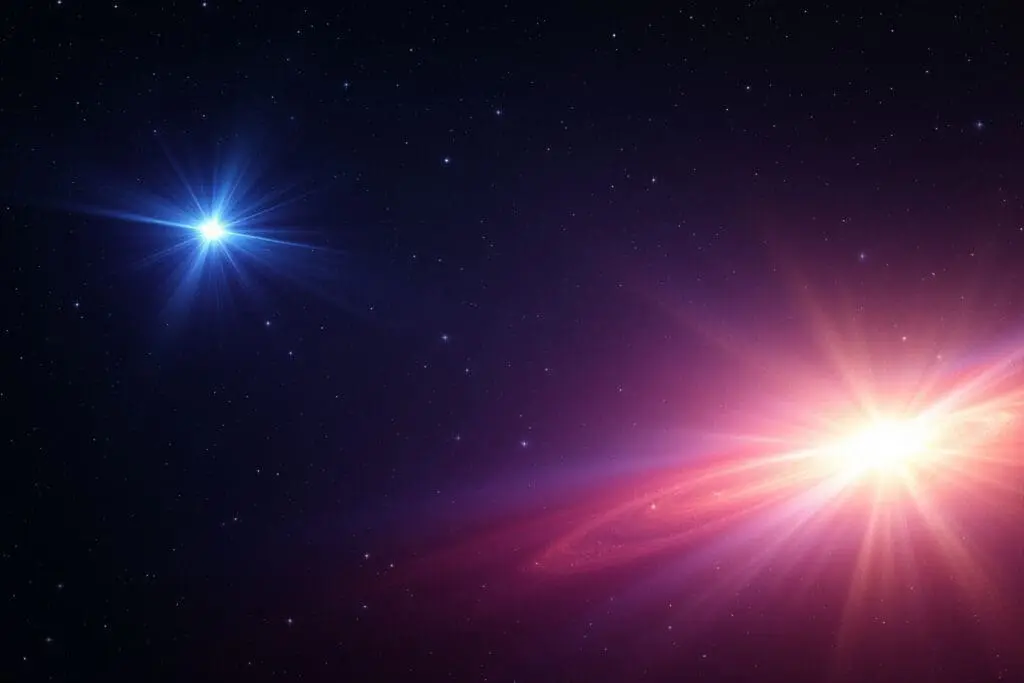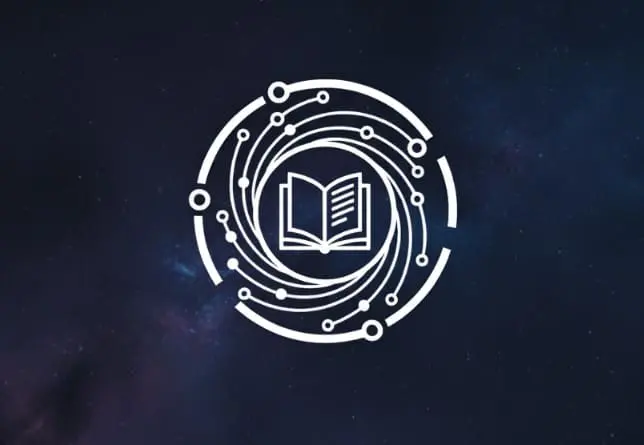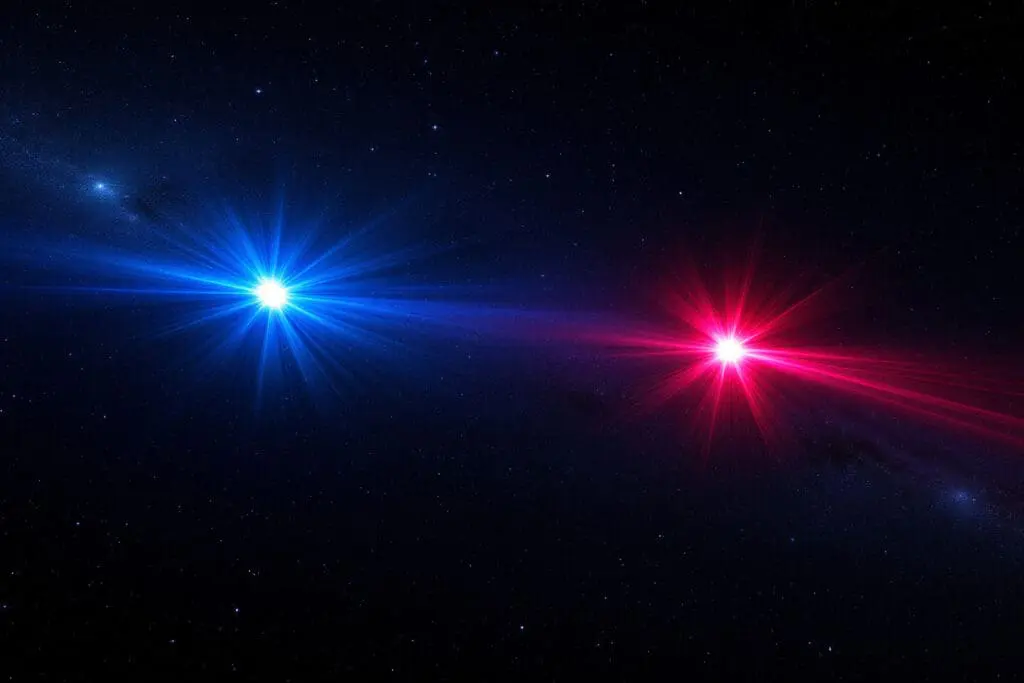Picture this. You’re on a sidewalk as an ambulance screams past, siren wailing. You hear that iconic neee-yoooow change in pitch, right? The siren sounds high as it approaches, then instantly drops the moment it passes and races away. That everyday experience, that simple audible shift, is actually the key to unlocking the universe’s greatest secrets. What you’re hearing is the Doppler effect. Now, just imagine that same principle working not with sound, but with light. And not on a city street, but across the unimaginable emptiness of space. This is the very essence of the doppler effect with light in space.
It’s a fundamental tool that gives astronomers the power to measure the cosmos, and it all boils down to two ideas: redshift and blueshift. This is how we know galaxies are hurtling away from us. It’s how we hunt for planets orbiting distant suns. In fact, it’s how we proved our universe burst forth from a Big Bang and has been expanding ever since. That familiar pitch-change from a siren has a visual cousin, one that paints a vivid picture of a universe in constant motion, literally stretching and squeezing the fabric of light.
More in Cosmic Physics Category
How Redshift Proves Universe Expansion
How Gravity Shapes the Universe
Key Takeaways
- At its core, the Doppler effect is the change in a wave’s frequency because of relative motion between the source and the observer. This works for sound and light.
- When a light source moves away from an observer, its light waves get stretched out. This shifts them toward the red end of the electromagnetic spectrum in a phenomenon known as redshift.
- On the other hand, when a light source moves toward an observer, its light waves get compressed. This shifts them toward the blue end of the spectrum, which we call blueshift.
- Astronomers use redshift and blueshift as a cosmic radar gun to clock the speed of celestial objects and see if they’re moving toward or away from Earth.
- The fact that almost all distant galaxies are heavily redshifted is the cornerstone evidence for the expansion of our universe, a concept called Hubble’s Law.
Ever Heard an Ambulance Siren Change Pitch? What if Light Did the Same Thing?
That classic “nee-nah” wail of an emergency vehicle is the perfect real-world example of the Doppler effect. It’s not some trick by the driver. The siren itself is blasting out sound waves at a perfectly constant frequency. The change you hear is purely about motion.
As the ambulance barrels toward you, it’s basically catching up to its own sound waves. Each new wave it emits has a shorter journey to your ear than the one before it. This process effectively squishes the waves together, shortening their wavelength. Our brains register this higher frequency as a higher pitch.
Then, whoosh. The moment it passes, the entire situation flips. Now, the vehicle is speeding away from the sound waves it’s sending your way. Each wave has a slightly longer journey than the one before it. This stretches the waves apart, increasing their wavelength. Your brain interprets this lower frequency as a lower pitch.
Makes sense, right?
So, here’s the critical leap. Light travels in waves, just like sound. Therefore, it has to play by the same rules. And it does. The principles behind the doppler effect with light in space are identical. The only difference is that instead of hearing a change in pitch, we see a change in color.
So, How Does This Pitch-Shifting Trick Work with Light?
Light is just one flavor of electromagnetic radiation, which exists across a massive spectrum. On one end, you have long, lazy, low-frequency waves like radio waves. On the other, you find short, energetic, high-frequency waves like X-rays and gamma rays. The beautiful rainbow of visible light that we can see is just a tiny, tiny sliver in the middle. Within this sliver, red light has the longest wavelength, and blue/violet light has the shortest.
When something out there in space, like a star or a whole galaxy, is moving relative to us, the light it gives off gets Doppler-shifted. Its light waves are either stretched or squeezed, just like the siren’s sound waves. This physical change pushes the light toward one end of the spectrum or the other.
This isn’t a change you can just go out and see. A star won’t suddenly look ruby red or sapphire blue in your telescope. The shift is incredibly subtle. It can only be found with high-tech instruments called spectrographs that act like cosmic prisms, spreading the starlight out into its full barcode of colors.
What Exactly Are We Seeing When Light “Stretches”?
Let’s imagine a star. It’s rocketing away from our solar system at an unthinkable speed. As it beams light in our direction, its own backward motion pulls on those light waves, stretching them out. This increase in the light’s wavelength pushes it toward the red end of the spectrum. Consequently, we call this phenomenon redshift.
But here’s a crucial point: a redshifted object doesn’t actually look red to our eyes. It just means its entire light signature—its unique spectral fingerprint—has been yanked towards the red end of the scale. It’s like a musician transposing a song into a lower key. The melody is the same, but every note is deeper.
Astronomers hunt for known patterns in starlight, specifically the unique barcodes left by elements like hydrogen. When they spot that entire barcode shifted towards the red, they know without a doubt that the object is moving away. The bigger the shift, the faster it’s going.
And What About When Light Gets “Squeezed”?
Now, let’s flip the scenario. A star is flying directly toward us. In this case, its forward motion compresses its light waves, which shortens their wavelength. This shoves the entire light signature toward the blue end of the spectrum. As you can guess, we call this blueshift.
Just as before, the object won’t actually appear blue. Its spectral barcode is simply displaced. A blueshift is a clear cosmic telegram telling us an object is heading our way. The most famous example is the Andromeda Galaxy, our closest galactic neighbor. Its light is blueshifted, which is how we know it’s on a collision course with our Milky Way. Don’t worry, though; the big crash is still a few billion years off.
This cosmic color-shifting is one of astronomy’s most powerful tools.
Is the Universe Playing a Cosmic Symphony on a Grand Scale?
The doppler effect with light in space is so much more than a neat party trick. It’s our cosmic speedometer. It’s our number one planet-hunting tool. By dissecting the light from faraway objects, we can decipher their movements and uncover secrets hidden within their systems.
For instance, the principle reveals more than just straight-line motion. It’s also the key to measuring rotation. As a distant galaxy spins, one edge of it rotates toward us while the opposite edge rotates away. As a result, the light from the approaching side gets blueshifted, while the light from the receding side gets redshifted. By measuring these opposing shifts, astronomers can calculate how fast the galaxy is spinning. That, in turn, helps them figure out its mass and structure. It’s like placing the universe on a turntable and listening to the music of its motion.
How Do Astronomers Use This to Clock the Speed of a Galaxy?
The whole process is a masterful piece of detective work. Every element leaves a unique spectral “fingerprint” on light, absorbing and emitting it at specific, unwavering wavelengths. Hydrogen, being the most common stuff in the universe, has a fingerprint that’s as familiar to astronomers as their own.
Here’s how they clock a galaxy’s speed:
- Know the Fingerprint: They start with a baseline, knowing the exact “rest wavelength” where hydrogen’s spectral lines should be if the object were perfectly still.
- Catch the Light: Then, using massive telescopes, they gather the faint light from a galaxy and feed it into a spectrograph, which reveals the spectral lines hidden within.
- Spot the Shift: Next, they look for that familiar hydrogen fingerprint. They always find it, but it’s almost never where it’s supposed to be. It’s been shifted.
- Do the Math: Finally, by measuring precisely how far the lines have moved, they calculate the redshift or blueshift. A straightforward formula then converts that shift into a radial velocity—the speed at which the galaxy is moving toward or away from us.
This method is the bedrock of how we understand the movements of the heavens.
Can a Star’s Wobble Tell Us if It Has Planets?
This is where the doppler effect with light in space gets really wild. The most successful technique for finding exoplanets is called the radial velocity method, and it depends entirely on spotting tiny, rhythmic Doppler shifts in a star’s light.
We tend to think of planets orbiting a stationary star, but gravity is a two-way street. The planet’s gravity also pulls on the star. This causes the massive star to perform a tiny “wobble” in space. It’s a bit like an Olympic hammer thrower leaning back to counterbalance the weight they’re spinning around.
We can’t see this wobble. Not from light-years away.
But we can see what it does to the star’s light. As the star executes its little dance, it periodically moves slightly toward us and then slightly away. This motion, however small, causes a repeating cycle of blueshifts and redshifts in its light. By watching a star and detecting this steady, rhythmic shifting, astronomers can confidently deduce the presence of an unseen planet. The size of the shift even tells them about the planet’s mass, and the timing of the wobble reveals how long it takes the planet to orbit its star.
Wait, Is the Doppler Effect Why the Universe Is Expanding?
Back in the 1920s, an astronomer named Edwin Hubble made a discovery that completely rewrote our understanding of everything. From his post at the Mount Wilson Observatory, he began measuring the redshifts of distant galaxies. He assumed he’d find a chaotic mix—some moving away, some moving toward us, a random cosmic dance.
But that’s not what he found. Not even close.
Hubble saw that virtually every galaxy was redshifted. They were all flying away from us. That alone was a bombshell. The real revelation, however, was his discovery of a clear pattern: the farther away a galaxy was, the faster it was receding. This direct relationship is now famously known as Hubble’s Law. The only possible conclusion was that the universe itself is expanding.
It’s a mistake to picture this as galaxies flying out from one central point. A better analogy is raisin bread baking in an oven. As the dough (spacetime) expands, it carries every raisin (galaxy) away from every other raisin. From any one raisin’s perspective, all the others seem to be rushing away, with the farthest ones moving the fastest. Hubble’s work, built on measuring redshift, provided the first hard proof of the Big Bang. You can learn more about his groundbreaking work directly from NASA’s overview of his discoveries.
Is All Redshift the Same, or Are There Cosmic Imposters?
As our knowledge grew, scientists began to realize that the redshift from the most distant galaxies was caused by something slightly different from the simple ambulance effect. This led to a critical distinction between two kinds of redshift. While they both stretch light waves, the reason behind the stretching reveals a profound truth about the cosmos.
Grasping this difference is fundamental to understanding our expanding universe. While the doppler effect with light in space handles motion through space, this other mechanism explains the behavior of space itself.
What’s the Difference Between Doppler and Cosmological Redshift?
Doppler redshift comes from an object’s physical motion through spacetime. The galaxy is literally traveling away from us, and that movement stretches the light. This is the main factor for nearby galaxies.
Cosmological redshift is a whole different beast. For the most distant galaxies, their mind-boggling redshift isn’t because they are speeding through space. It’s because space itself has expanded while their light was traveling to us. Over the billions of years that light journeyed across the cosmos, the very fabric of spacetime it was traveling through stretched. The light wave, in turn, was stretched right along with it.
Think back to the raisin bread. The raisins aren’t actually moving through the dough. The dough itself is expanding, and that’s what creates the separation. Light from a distant galaxy is like a line drawn on that dough—as the loaf puffs up, the line gets longer.
Why Does This Distinction Even Matter?
This is a profoundly important distinction. If the enormous redshifts we see were just a Doppler effect, it would imply we are at the center of a colossal explosion, with everything flying away from us. That would put Earth in a uniquely privileged spot, a scientific idea that has been out of favor since Copernicus.
The cosmological redshift model, however, tells a different story. It perfectly supports the idea that the universe looks pretty much the same from everywhere. There is no center. An observer in any galaxy would see the exact same thing: all other galaxies rushing away. It confirms we aren’t special; we’re just one part of a vast, dynamic cosmos where the stage itself is growing.
Could Gravity Itself Bend and Stretch Light?
As if that weren’t enough, Albert Einstein’s theory of general relativity pointed to a third, even stranger type of redshift. This kind has nothing to do with motion at all. It’s all about gravity. Einstein showed that massive objects don’t just pull on things; they warp the very fabric of spacetime, creating what we call a “gravity well.”
His theory predicted that light is affected by this warping. As light climbs “uphill” out of a deep gravity well—like the one created by a super-dense star or a black hole—it has to expend energy. This energy loss doesn’t make the light slow down; its speed is constant. Instead, the light wave loses frequency and its wavelength gets longer.
The result is gravitational redshift. Light gets stretched simply by the effort of escaping a powerful gravitational field. This effect is incredibly tiny and difficult to spot, but it has been measured and confirmed, proving yet again that Einstein was right. It reveals a universe that is stranger, more wonderful, and more interconnected than we ever could have imagined.
FAQ – The Doppler Effect with Light in Space

What distinguishes cosmological redshift from Doppler redshift, and why is this difference important?
Doppler redshift results from an object moving through space, while cosmological redshift occurs because space itself is expanding; this distinction is important because it influences our understanding of the universe’s structure, supporting the idea that the universe has no center and is expanding uniformly.
Can the Doppler effect also help in finding planets around distant stars?
Yes, the Doppler effect enables astronomers to detect exoplanets by observing small variations in a star’s light due to the gravitational tug of orbiting planets, causing the star to wobble and produce rhythmic shifts in its spectral lines.
What is the significance of redshift in understanding the expansion of the universe?
Redshift is critical evidence for the universe’s expansion, as it shows that most galaxies are moving away from us; the greater the redshift, the faster the galaxy recedes, supporting Hubble’s Law and the Big Bang theory.
How do astronomers use redshift and blueshift to measure the movement of celestial objects?
Astronomers analyze the spectral lines in light from celestial objects, and by measuring how much these lines are shifted from their known rest wavelengths, they can determine the speed and direction of an object’s motion relative to Earth.
What is the Doppler effect and how does it apply to light in space?
The Doppler effect is the change in a wave’s frequency caused by the relative motion between the source and the observer, and it applies to light in space by causing shifts in the light’s wavelength, resulting in redshift or blueshift depending on whether the source is moving away from or toward the observer.

